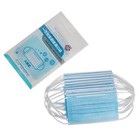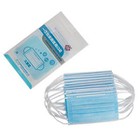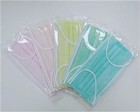What Are The Implementation Standards For Children's Masks?
Implementation standards for children's masks:
1. Protection performance
Children's protective masks require a particle filtration efficiency of not less than 95% and a protective effect of not less than 90%; children's sanitary masks require a particle filtration efficiency of not less than 90% and a bacterial filtration efficiency of not less than 95%.
2. In terms of comfort performance
Considering the respiratory characteristics of children in the physiological development stage, children's protective masks require that both the expiratory resistance and inspiratory resistance are not higher than 45Pa; children's sanitary masks require that the ventilation resistance is not higher than 30Pa. In terms of the comfort of wearing masks, the standard recommends the use of adjustable mask straps.
3. Safety performance
The mask should be able to cover the mouth, nose, and jaw safely and securely, and there should be no palpable sharp tips and edges, and should not significantly affect the field of vision: The raw materials of the mask should not use recycled materials and materials that can cause adverse reactions, and should not pass through chlorine-containing materials. Bleaching; for masks equipped with breathing valves, the breathing valves should be firm and not deformed, and the inner parts should not fall off; lace-up mask straps should not be used; the nose clip should be folded in half without breaking; the inner material of the mask should not be printed or dyeing.
The standard strictly stipulates the residue of harmful substances, and the formaldehyde content should not be higher than 20mg/kg; the printing pattern on the outer layer of the mask should not fade, and the decomposable carcinogenic aromatic ammonia dye is prohibited; the residual amount of ethylene oxide sterilization should not be higher than 2μg/g; Migration of fluorescent whitening substances shall not be detected.
The standard also stipulates that the microbial indicators should meet the requirements of disposable sanitary products.
4. Wear safety warnings
The recommended national standard of the "Children's Mask Technical Specifications" gives clear wearing safety warnings for the use of children's masks. For example, children should wear masks under the care of adults, and caregivers should observe and educate children to wear masks correctly. Children should not play or do moderate or above-medium-intensity exercise while wearing the mask, and should not disassemble the breathing valve and the internal parts of the breathing valve; if symptoms such as breathing discomfort or skin allergy occur during wearing, the mask should be removed in time, and if necessary, it should be taken off immediately. seek medical attention. Masks should be replaced in time. It is not recommended to reuse masks after washing, and used masks cannot be exchanged. Children with breathing difficulties are not recommended to wear masks. Objects unrelated to the wearing of the mask should be cleaned up during use, etc.
Related News
- Coronavirus: Disposable Masks 'causing A Lot Of...
- It Takes 450 Years For Disposable Face Mask To ...
- What Is The Difference Between Pink Medical Mas...
- Can The KN95 Mask Prevent New Coronary Virus?
- As The Temperature Rises, Can Fancy Masks And S...
- Why Do New Masks Smell Bad?
- How To Distinguish The Front And Back Of The Mask?
- How Long Can A Disposable Mask Be Worn?
- Medical Masks Have Become A Favorite Item For M...
- Can Masks Be Reused? In Both Cases, The Mask Ca...
- Do You Know The Correct Way To Clean And Mainta...
- Can Wearing A Mask Prevent Secondhand Smoke? Wh...
- Can Wearing A Mask Prevent Secondhand Smoke? Wh...
- What Kind Of Garbage Are Disposable Masks?
- Standard For Children's Masks
- How Many Times Can Disposable Masks Be Used? Ar...
- What Kind Of Garbage Is Disposable Mask? Is Dis...
- Difference Between Sterilized And Non Sterilize...
- Do Masks Have A Shelf Life
- Why Don't Americans Wear Masks
Related Products








